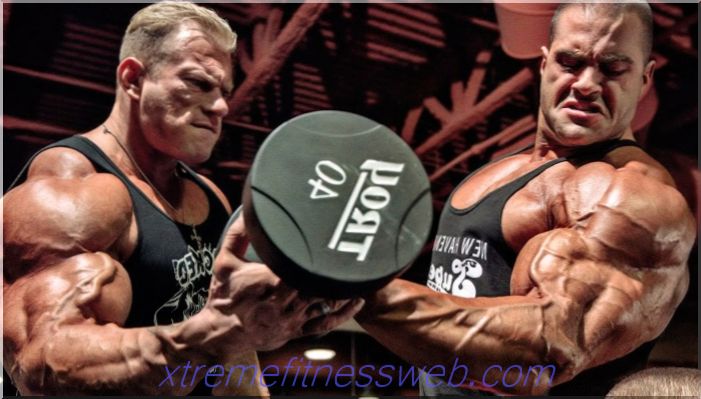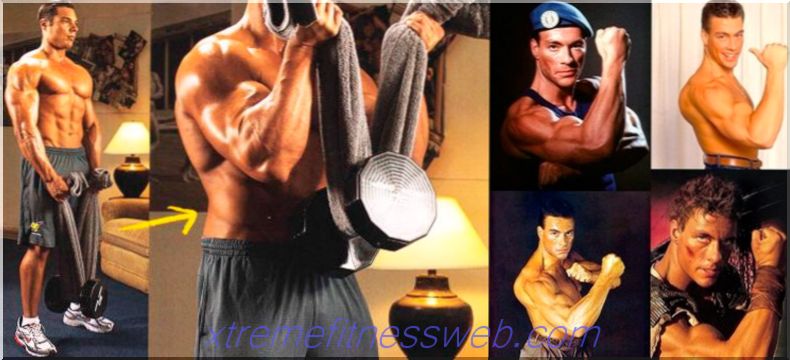- Why do muscles ache after training
- Types of muscle pain
- Muscles hurt after training - is this a bad or good sign ">
Muscle pain is an optional sign of muscle gain, but they confirm that during the training the muscle structures are destroyed and microscopic injuries are formed, which means that the treatment process and the formation of new structural tissues begin.
The success of the training is not measured by pain. The absence of this sensation does not mean that the lesson was unsuccessful. Contreras and Schonfeld, American researchers of this process, say that testing post-workout pain is not always a sign that muscles are growing.
The main goal of each training should not be getting pain, but the progression of the loads. The effectiveness of the lessons is not shown by pain, but by an increase in the girth and volume of muscles, as well as a comparison of the physique before the start of classes and after training.
How to prevent pain after a workout
- How to reduce pain after a workout
- Summarizing

The end of each workout brings not only a sense of self-satisfaction, but also muscle pain. It is completely different. Both pleasant fatigue and aching pain can be felt, which prevents muscle tissue from contracting completely. To understand why this happens, you need to become more familiar with how the loads act on the muscles. Thanks to the understanding of the onset of pain after training, you can minimize and muffle this not always pleasant feeling.
Most often, novices and athletes experience painful sensations after a long pause in training or changing one program to another. Everyone wants to not suffer from aching pain, but this consequence can be avoided only when there is a clear idea of why the pain appears at all.
Content
- 1 Why muscle pain after exercise
- 2 Types of Muscle Pain
- 2.1 Moderate post-workout
- 2.2 Delayed
- 2.3 Injury pain
- 3 Muscles hurt after training - this is a bad or good sign "> 4 How to prevent pain after training
- 5 How to reduce pain after exercise
- 6 Summary
Why do muscles ache after training

Pain sensation is a reflection of the process during which muscle structures are destroyed. According to a study conducted by Sterlig and Morozov, performing physical exercises shifts myofibrils of muscle fibers, mitochondria break up, which provokes an increase in the level of white blood cells in the blood. A similar condition occurs with injuries, inflammation, infections.
As a result of the destruction of muscle tissue fibers, protein fragments of molecules are formed, and cells that digest damaged tissues, which are called phagocytes and lysosomes, are activated. They produce foods that cause pain. Muscle fibers, breaking down, form satellites, which are cells that provoke tissue production of protein.

There is another fact that does not cause any doubt, namely that the painful sensations during bodybuilding are felt especially acutely only after the first training, and then, when they become regular, they are almost not felt. If a long pause is made in the classes, then they reappear.
When training is completed, protein production is accelerated in the body, which leads to the accumulation of creatine phosphate in muscle tissue, increase the level and activation of glycolysis enzymes. This process becomes much more effective over time, and, therefore, oxidation occurs, which is a source of energy for muscle contractions. The amount of training is the reason that the depletion of the source of energy for muscle energy becomes almost impossible.
Thanks to regular training, the energy potential for muscles, and, consequently, performance indicators with strength, is increased. On the other hand, there is a reduction in applied stress and the impact of training. The reverse reaction is that muscle adaptation slows down. This phenomenon was called the training plateau, when to make a breakthrough it is necessary to change the load and factors of training, changing the splits, the time for rest between sets, the exercises performed using super sets, drops, and so on.
Types of muscle pain
There are several types of pain that occur after each workout.
Moderate post-workout

It begins to be felt in the muscles the next morning after performing strength training. Muscles become viscous, cottony, swollen and full when an action is performed through the muscle group involved in the training. A pleasant feeling of fatigue and almost imperceptible pain, which intensifies if the muscles are stretched or contracted.
The pain lasts for several days. This is evidence that microtrauma appeared in muscle tissue and the recovery process begins, accompanied by the formation of new structures.
Retarded
Appears two to three days after the completion of the training. If the muscles are stretched or contracted, then it becomes strong. It most often occurs after changes in the training program, a long break in classes, as well as in beginners.
Aching strong and ongoing pain is evidence that the load is too excessive, the weights are taken too large. Increasing the load is recommended gradually. This allows the joints, muscles, ligaments, and the central nervous system to become stronger and more accustomed.
When before the next training, the muscles have not yet had time to fully recover, that is, they continue to hurt, a restorative session should be carried out. It is not necessary to change the exercises, but weights are reduced by half - by 50 percent. If you make sets of 15-20 repetitions in each, then the damaged muscle will receive a large amount of blood, which helps to improve circulation and supplies them with nutrients that contribute to recovery processes.
Pain caused by trauma

It is shackling and sharp, coming both the next day and immediately after classes. She does not allow to do any exercises, since the pain is quite strong. Injuries, as a rule, happen when weights are taken as extreme as possible, and a minimum of time is given to the warm-up.
Soreness of ligaments or joints is not normal. Therefore, it is recommended that you completely stop doing the exercise until you can figure out the exact reason why the pain occurs. It may consist in that the injury is not completely cured, the technique is incorrect, the simulator is not configured for anthropometric personal parameters, and so on.
Another kind of post-workout muscle pain is the occurrence of a burning sensation during the final repetitions in various exercises. This is the result of the oxidation of muscle tissue by lactic acid. It fills the muscle cells and prevents the nerve impulse from passing, which causes a burning sensation.
This feeling is absolutely normal, it is a response of the body, which protects it from overload. Lactic acid waste products are excreted approximately 20 or a maximum of 30 minutes after the end of the training.
Training goals most often lead to the need to engage in a burning sensation, that is, for lagging, slow, direct muscle groups.
Muscles hurt after training - is this a bad or good sign ">
Muscle pain is an optional sign of muscle gain, but they confirm that during the training the muscle structures are destroyed and microscopic injuries are formed, which means that the treatment process and the formation of new structural tissues begin.
The success of the training is not measured by pain. The absence of this sensation does not mean that the lesson was unsuccessful. Contreras and Schonfeld, American researchers of this process, say that testing post-workout pain is not always a sign that muscles are growing.
The main goal of each training should not be getting pain, but the progression of the loads. The effectiveness of the lessons is not shown by pain, but by an increase in the girth and volume of muscles, as well as a comparison of the physique before the start of classes and after training.
How to prevent pain after a workout

It is almost impossible to completely feel muscle pain. When training increases, it becomes less pronounced. There are several important points that allow you to effectively engage, but feel extremely pleasant, but not aching or breaking pain:
- Loads should progress . Thus, only a small amount of weight is added weekly to weight. If you perform a bench press with a barbell, then the optimal addition will be from 2.5 to 5 kg every week. After weight gain, you should master the technique of execution, maintain a given number of sets and approaches, and then proceed to add weight.
- The execution technique must be mastered to perfection. You can contact a trainer or someone who knows. If this is not possible, then you can always find information on how to do this or that exercise.
- Be sure to do a warm-up. It is an integral part of the start of training, includes a full range of movements for the whole body, as well as preparation for the upcoming training. If you do a bench press, then perform from 2 to 3 warm-up sets with low weights and a small number of repetitions. This will provide a rush of blood to the muscles and establish a connection with the nervous system.
- Do not train tired. A large amount of work, lack of sleep, poor mood and lack of the ability to eat well during the day - this is a good reason to abandon training, so as not to expose your body to additional stress.
- Observe drinking regimen. In class, you need to drink a minimum of a liter of water. The daily rate of fluid intake is 0.04-0.05 * dead weight. Thanks to water, the blood does not thicken, the delivery of oxygen and nutrients is accelerated, and the passage of nerve impulses to muscle tissues improves.
- Try to sleep well. It is best to sleep at least 8 hours.
How to reduce pain after a workout

To reduce pain, you must resort to the following methods:
- Massage . It allows you to disperse blood throughout the body, to ensure the flow of nutrients to the desired areas.
- Restorative occupation. This training involves the use of 50% of the usual working weights with 15-20 repetitions in the set, which gives blood flow to the muscles. They get nutrients and recover faster. The meaning of such activities is not only to reduce pain, but also to repeat the technique of movements, honing your skills.
- Zaminke. Due to muscle stretching, blood flow increases, which increases and accelerates the process of removing damaged cells, and, therefore, reduces pain.
- Proper nutrition. A lot of protein must be present in the diet, the amount of which is from 2 to 2.5 g per 1 kg of body weight. To prevent catabolism, to obtain simple amino acids, BCAA should be taken. This also applies to glutamine, which also strengthens the immune system, which helps to accelerate the full recovery of the body. Taking creatine can increase the stamina and strength of muscle tissue by increasing the concentration of creatine phosphate.
- Have a good rest . If there are pains that prevent you from practicing, you should take a break for 2-5 days. This will allow you to fully recover and begin classes with renewed vigor.
Along with these methods, you can resort to hardening, visiting a bath, sauna, using a warming ointment, and so on. These methods lead to improved blood circulation in damaged structures, which allows muscles to recover much faster.
Summarizing
The painful sensations after the training are a sure sign that the muscles are sore, which means that microtraumas were received, which are evidence that the classes were successful. The main thing is to be able to distinguish between bad and good pain. They should not be afraid of it, but it is necessary to give rest and muscle recovery. Otherwise, there will be no positive result from the training.







